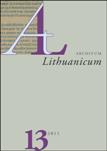Baltų kalbų morfologija
The Morphology of Baltic
Author(s): Saulius Ambrazas, William SchmalstiegSubject(s): Theoretical Linguistics, Morphology, Baltic Languages
Published by: Lietuvių Kalbos Institutas
Keywords: Baltic languages; Morphology; derivational; noun formation;
Summary/Abstract: In the Baltic languages (differently from Germanic, OI nd and Classical Gk) there are relatively few compound words. Particularly old is Li viešpatìs ‘lord’ (cf. OI nd viś‑pátiḥ ‘chief of a settlement or tribe’). In the Baltic languages the absolute majority of derived nouns and Adjs are suffixal and ending derivatives. Various derivational affixes have been studied for a long time. Vincas Urbutis began to apply modern methods to the study of noun formation and relying on these described exhaustively the system of noun formation in contemporary Li distinguishing thereby the various semantic derivational categories. The derivational category is the class of derivatives which have a common derivational meaning and special derivational affixes. Recent research shows that Baltic distinguishes three old categories of nouns derived from verbs [1.1–1.3] and five old categories derived from nouns [1.4–1.8].
Journal: Archivum Lithuanicum
- Issue Year: 2011
- Issue No: 13
- Page Range: 131-146
- Page Count: 16
- Language: Lithuanian

